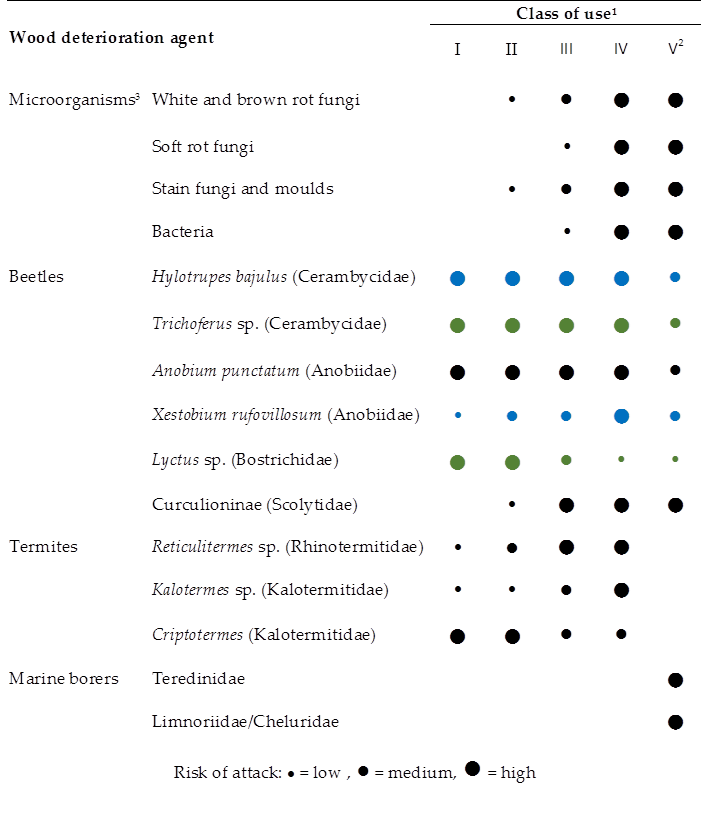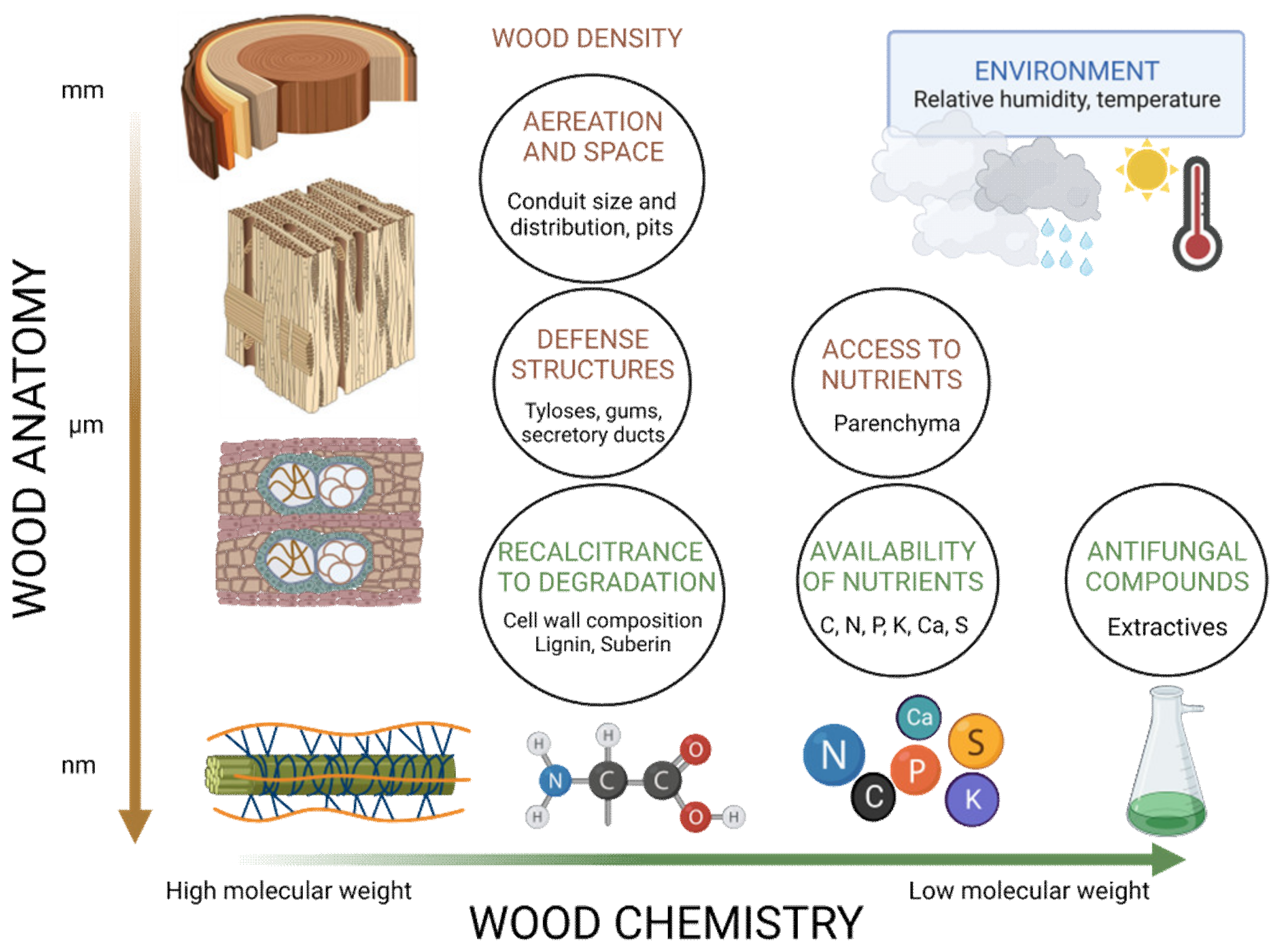
| Version | Summary | Created by | Modification | Content Size | Created at | Operation |
|---|---|---|---|---|---|---|
| 1 | Juan A. Martín | -- | 1560 | 2023-05-05 13:02:10 | | | |
| 2 | Catherine Yang | + 2 word(s) | 1562 | 2023-05-06 03:05:33 | | |
Video Upload Options
The use of wood has gained social interest, leading to a global increase in its demand. Yet, this demand is often covered by the production of woods of low natural durability against biological deterioration. The main biological agents with the potential to attack the structural integrity of wood are wood-decay fungi, saproxylic beetles, termites, and marine molluscs and crustaceans. In most circumstances, fungi are the main wood-deteriorating agents. To attack the cell wall, wood-decay fungi combine a complex enzymatic mechanism with non-enzymatic mechanisms based on low-molecular-weight compounds. In some cases, the larvae of saproxylic beetles can also digest cell wood components, causing serious deterioration to wooden structures. The impact of subterranean termites in Europe is concentrated in the Southern countries, causing important economic losses. However, alien invasive species of voracious subterranean termites are expanding their presence in Europe. Wooden elements in permanent contact with marine water can be readily deteriorated by mollusc and crustacean borers, for which current preservatives lack efficacy. The natural durability of wood is defined as the inherent resistance of wood to catastrophic action by wood-destroying organisms. Besides exposure to the climate, product design and use conditions, the natural durability of wood is key to the prediction of the service life of wooden products, which can be shortened due to the impact of global change.
1. Biological Agents Responsible for Wood Deterioration and Potential Shifts Caused by Global Change

2. Factors Underlying the Natural Durability of Wood against Biological Deterioration

References
- Marais, B.N.; Brischke, C.; Militz, H. Wood Durability in Terrestrial and Aquatic Environments—A Review of Biotic and Abiotic Influence Factors. Wood Mater. Sci. Eng. 2022, 17, 82–105.
- Simler-Williamson, A.B.; Rizzo, D.M.; Cobb, R.C. Interacting Effects of Global Change on Forest Pest and Pathogen Dynamics. Annu. Rev. Ecol. Evol. Syst. 2019, 50, 381–403.
- Liebhold, A.M.; Brockerhoff, E.G.; Garrett, L.J.; Parke, J.L.; Britton, K.O. Live Plant Imports: The Major Pathway for Forest Insect and Pathogen Invasions of the US. Front. Ecol. Environ. 2012, 10, 135–143.
- Bale, J.S.; Masters, G.J.; Hodkinson, I.D.; Awmack, C.; Bezemer, T.M.; Brown, V.K.; Butterfield, J.; Buse, A.; Coulson, J.C.; Farrar, J.; et al. Herbivory in Global Climate Change Research: Direct Effects of Rising Temperature on Insect Herbivores. Glob. Chang. Biol. 2002, 8, 1–16.
- McAvoy, T.J.; Régnière, J.; St-Amant, R.; Schneeberger, N.; Salom, S. Mortality and Recovery of Hemlock Woolly Adelgid (Adelges tsugae) in Response to Winter Temperatures and Predictions for the Future. Forests 2017, 8, 497.
- Addison, A.L.; Powell, J.A.; Six, D.L.; Moore, M.; Bentz, B.J. The Role of Temperature Variability in Stabilizing the Mountain Pine Beetle–Fungus Mutualism. J. Theor. Biol. 2013, 335, 40–50.
- Brischke, C.; Rapp, A.O. Potential Impacts of Climate Change on Wood Deterioration. Int. Wood Prod. J. 2010, 1, 85–92.
- Harju, A.M.; Venäläinen, M.; Beuker, E.; Velling, P.; Viitanen, H. Genetic Variation in the Decay Resistance of Scots Pine Wood against Brown Rot Fungus. Can. J. For. Res. 2001, 31, 1244–1249.
- Hillis, W. Distribution, Properties and Formation of Some Wood Extractives. Wood Sci. Technol. 1971, 5, 272–289.
- Taylor, A.M.; Gartner, B.L.; Morrell, J.J. Heartwood Formation and Natural Durability—A Review. Wood Fiber Sci. 2002, 34, 587–611.
- Wheeler, E.A.; Baas, P.; Gasson, P.E. IAWA List of Microscopic Features for Hardwood Identification. IAWA Bull. 1989, 10, 219–332.
- Pâques, L. Genetic Control of Heartwood Content in Larch. Silvae Genet. 2001, 50, 69–74.
- Climent, J.; Chambel, M.; Pérez, E.; Gil, L.; Pardos, J. Relationship between Heartwood Radius and Early Radial Growth, Tree Age, and Climate in Pinus canariensis. Can. J. For. Res. 2002, 32, 103–111.
- Margolis, H.A.; Gagnon, R.R.; Pothier, D.; Pineau, M. The Adjustment of Growth, Sapwood Area, Heartwood Area, and Sapwood Saturated Permeability of Balsam Fir after Different Intensities of Pruning. Can. J. For. Res. 1988, 18, 723–727.
- Weedon, J.T.; Cornwell, W.K.; Cornelissen, J.H.C.; Zanne, A.E.; Wirth, C.; Coomes, D.A. Global Meta-Analysis of Wood Decomposition Rates: A Role for Trait Variation among Tree Species? Ecol. Lett. 2009, 12, 45–56.
- Kahl, T.; Arnstadt, T.; Baber, K.; Bässler, C.; Bauhus, J.; Borken, W.; Buscot, F.; Floren, A.; Heibl, C.; Hessenmöller, D.; et al. Wood Decay Rates of 13 Temperate Tree Species in Relation to Wood Properties, Enzyme Activities and Organismic Diversities. For. Ecol. Manag. 2017, 391, 86–95.
- De Ligne, L.; Van den Bulcke, J.; Baetens, J.M.; De Baets, B.; Wang, G.; De Windt, I.; Beeckman, H.; Van Acker, J. Unraveling the Natural Durability of Wood: Revealing the Impact of Decay-Influencing Characteristics Other than Fungicidal Components. Holzforschung 2021, 75, 368–378.
- Scheffer, T.C.; Cowling, E. Natural Resistance of Wood to Microbial Deterioration. Annu. Rev. Phytopathol. 1966, 4, 147–168.
- Hillis, W.E. Heartwood and Tree Exudates; Springer Science & Business Media: Berlin/Heidelberg, Germany, 2012; Volume 4, ISBN 3-642-72534-1.
- Nault, J. Radial Distribution of Thujaplicins in Old Growth and Second Growth Western Red Cedar (Thuja plicata Donn). Wood Sci. Technol. 1988, 22, 73–80.
- Anderson, A.B.; Scheffer, T.C.; Duncan, C.G. The Chemistry of Decay Resistance and Its Decrease with Heartwood Aging in Incense Cedar (Libocedrus decurrens Torrey); University of California Forest Products Laboratory: Richmond, CA, USA, 1963.




